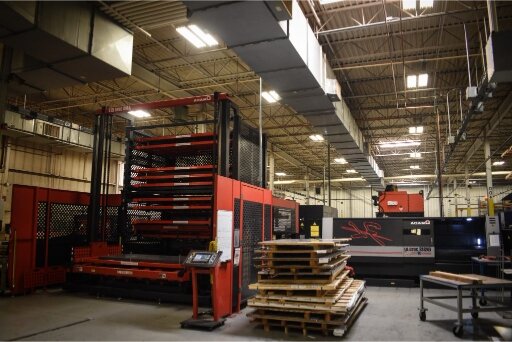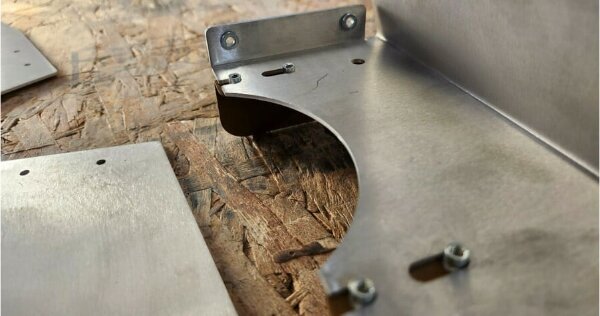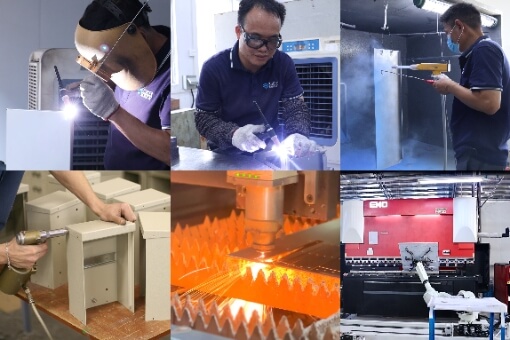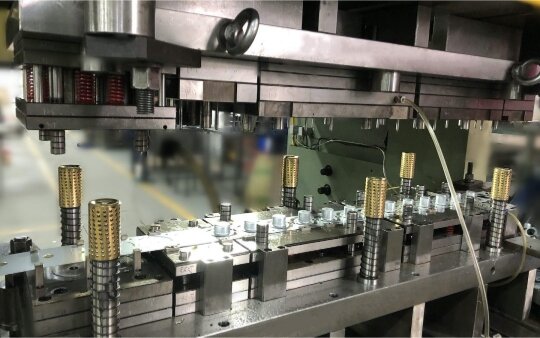金属部品をより丈夫に、より美しくするために粉体塗装を選ぶ人は多い。しかし、コーティングの厚さについてはあまり考えないかもしれない。薄すぎると、コーティングが欠けたり磨耗が早まったりする。厚すぎると、見た目が不均一になったり、ひび割れたり、必要以上のコストがかかったりします。この単純な要素によって、パーツの耐久性、見た目、機能性が変わってくるのです。
パウダーコーティングの厚みは、パーツの外観や耐久性に大きく影響します。それでは、厚みがプロジェクトのさまざまな側面にどのような影響を与えるかを説明しましょう。
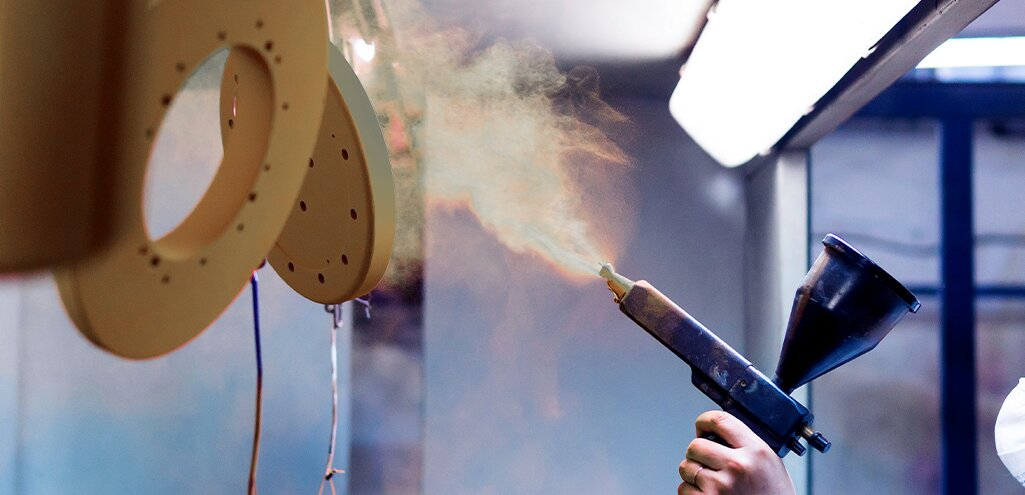
粉体塗装の厚みとは?
粉体塗装の厚みは、表面に塗布されたコーティングの深さです。塗膜の上面から下面の部品表面までの長さで表される。この層は乾燥粉末として使用され、その後熱で硬化させることで強固な仕上げとなります。厚みは、コーティングの密着性、耐摩耗性、部品の保護に影響します。
理想的な粉体塗装の厚さは2~5ミル(50~125ミクロン)です。これにより、強力な保護、滑らかな外観、性能上の問題がなくなります。この範囲を超えると、欠けや接着不良、余分なコストの原因となります。
コーティングが薄いと、斑点状に見えたり、すぐに磨耗してしまったりすることがあり、厚いと硬化中に気泡や亀裂が生じることがあります。そのため、厚みの測定は品質管理における重要なステップなのです。
測定単位:ミルとミクロン
粉体塗装の厚さは通常 きんぴら または ミクロン.
- 1ミル=0.001インチ
- 1ミクロン=0.001ミリ
米国ではミルが一般的。欧州やその他の地域ではミクロンが一般的です。両者を比較すると
- 1ミル=25.4ミクロン
ほとんどの粉体塗装ゲージには、両方の単位が表示されています。正しい単位を使用することで、検査や報告の際のミスを防ぐことができます。
アプリケーションタイプ別の代表的な厚み範囲
使用する場所や方法によって、必要なコーティングの厚さは異なる:
- 屋内装飾部品:1.5~2.5ミル(38~63ミクロン)
- 一般産業部品2.0~3.5ミル(50~90ミクロン)
- 自動車用および屋外用:3.0~5.0ミル(75~125ミクロン)
- ヘビーデューティーまたは船舶用部品:5.0~10.0ミル(125~250ミクロン)
粉体塗装の厚さの基準
標準規格は、粉体塗装の塗布と膜厚チェックのための明確なルールを示しています。これにより、部品が性能と安全性の目標を確実に満たすことができます。
ASTM規格
- ASTM D7091 は、磁気ゲージと渦電流ゲージを使用した乾燥膜厚の測定方法を説明する。
- ASTM D1186 は、金属基板上の非磁性コーティングの非破壊検査に焦点を当てている。
米国では、生産・検査時の塗膜厚チェックに広く使用されている。
ISO規格
- ISO 2360 は、非導電性塗膜の渦電流測定器を用いた塗膜厚測定法について述べている。
- ISO 2808 は、塗装面や粉体塗装面の世界標準規格で、破壊と非破壊の両方の厚さ試験オプションを提供しています。
ISO規格は国際契約において一般的であり、国境を越えた品質の整合に役立つ。
EN規格
- EN 13523 には、コイル被覆金属の試験方法を網羅する複数のパートが含まれている。
- ヨーロッパでは、建築、家電、輸送用途によく使用されている。
業界認定
一部の業界では、グローバル・スタンダードと並行して自社のプログラムを使用している:
- クオリコート (建築):コーティングの厚さは 2.0~2.4ミル (50-60ミクロン)。
- AAMA 2605 (建築用アルミニウム):募集 最低2.8ミル (70ミクロン)と耐候性試験を実施した。
- OEM規格:自動車ブランドや家電ブランドは、コーティングの厚さやテストについて社内で仕様書を作成することがある。
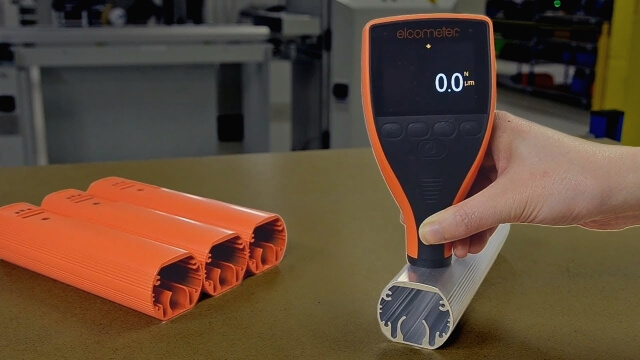
厚みが性能に与える影響
粉体塗装の厚みは部品の性能に直接影響します。厚さを間違えると、保護性能が低下したり、ひび割れが生じたり、仕上がりが粗くなったりします。
耐食性と保護
適切な厚みは表面を密閉し、湿気や塩分、化学物質をシャットアウトします。コーティングが薄すぎると、水や空気が金属に到達し、腐食が始まります。
沿岸部や工業地帯のような過酷な環境では、コーティングを厚くした方が長期的な保護効果が高くなります。しかし、厚さだけでは十分ではありません。コーティングはまた、よく硬化し、表面にしっかりと接着しなければなりません。
柔軟性と接着性への影響
コーティングが厚すぎると、もろくなります。こうなると、部品が破損したときにひびが入ったり欠けたりしやすくなる。 屈曲 またはフレックス。
コーティングが薄いと柔軟性は増しますが、十分なカバー力が得られない場合があります。理想的な厚みは、コーティングを壊すことなく、部品がわずかにたわむことを可能にします。また、硬化中のパウダーの付着も良くなります。
外観と仕上げ品質への影響
厚みが均一でなかったり不正確であったりすると、完成品の外観が損なわれることがあります。薄い斑点はくすんで見えたり、色あせて見えたりする。厚いスポットは、オレンジピールやドリップのような質感の問題につながる可能性があります。
適切な膜厚にすることで、滑らかで均一な光沢のある仕上がりになります。また、色がより濃く見え、パーツ全体に一貫性が生まれます。
最終的なコーティングの厚さに影響する要因
粉体塗装の厚さには、使用する方法、粉体そのもの、表面の処理方法など、いくつかの要因が影響する。
申込方法
静電スプレーが最も一般的な方法である。スプレーガンで粉末を帯電させ、接地した金属部分に付着させる。スプレーされる粉末の量と武器からの距離が最終的な厚さに影響する。
流動床コーティング は、加熱された部品を、浮遊する粉末粒子の入った容器に浸す。パウダーは溶けて表面に付着する。この方法は通常、より厚いコーティングを作り出し、重荷重部品に効果的である。
それぞれの方法によって、標準的な厚さの範囲は異なる。スプレーコーティングは通常1.5~5.0ミル、流動床コーティングは10ミル以上になる。
粉末の種類と粒子径
すべてのパウダーが同じ挙動をするわけではありません。流れが良いもの、溶けるのが早いもの、堆積が早いものなどがある。樹脂の種類(エポキシやポリエステルなど)は、問題が発生するまでのコーティングの厚さに影響します。
粒子の大きさも重要だ。粒子が大きいと、コーティングが厚くなる傾向があります。細かいパウダーは、より滑らかな仕上がりになることが多いのですが、薄い斑点を避けるために、よりコントロールする必要があります。
基材の材質と表面状態
パーツの表面によって、パウダーの付き方が変わる。滑らかな金属や光沢のある金属は、粉を保持できず、薄い斑点ができることがある。表面がざらざらしていたり、テクスチャーがあったりすると、より多くのパウダーを閉じ込めることができ、コーティングを厚くすることができる。
表面処理的 サンドブラスト または化学的な前処理を使用することで、接着を向上させることができます。きれいで均一な表面は、部品全体の厚みを一定にするのにも役立ちます。
オペレーターのテクニックと機器の設定
粉の噴霧方法は重要な役割を果たします。ガンの速度、部品からの距離、スプレーの角度など、すべてが粉の堆積量に影響します。
電圧、空気圧、パウダー流量などの装置設定は、パーツの形状やサイズに基づいて調整する必要があります。熟練したオペレーターであっても、装置の設定が適切でなければ、不均一なコーティングを施してしまうことがある。
パウダーコートの厚さの測定
コーティングの厚みを測定することで、問題を早期に発見することができます。最終的な仕上がりが見た目と性能の両方の基準を満たしていることを保証します。硬化前と硬化後の厚みをチェックする方法はさまざまです。
硬化前の測定方法(DFT予測)
硬化の前に、パウダーの蓄積をチェックすることで、最終的な乾燥膜厚(DFT)を見積もることができます。これは通常
- 櫛型ゲージ:簡単な道具をパウダーに押し付け、どれだけ蓄積されたかを確認する。
- レーザーまたは超音波センサー:より高度なセットアップのための非接触方式。
これらの方法はあくまで推定に過ぎない。パウダーは硬化中に溶けたり流れたりするため、最終的な厚みが変わる可能性がある。それでも、早めのチェックはコーティングの過不足を防ぐのに役立ちます。
ポストキュア厚み測定ツール
硬化後、コーティングは固化する。ほとんどの検査はこの時に行われる。道具は以下の通り:
- 磁気ゲージ は鋼鉄や鉄のコーティングに使用される。表面とその下の金属との距離を測定する。
- 渦電流計:アルミニウムのような非磁性金属に最適。電気抵抗を測定することで、コーティングの厚さを検出する。
どちらのツールも高速で使いやすく、非破壊検査が可能です。ほとんどのデジタル式は、厚さをミルまたはミクロン単位ですぐに表示する。
正確な測定における共通の課題
正確な測定は必ずしも容易ではありません。よくある問題には以下のようなものがある:
- 粗い路面や凹凸のある路面:誤った測定値につながる可能性がある。
- エッジエフェクト:厚みは、エッジやコーナーで薄くなる傾向がある。
- オペレーターエラー:ゲージを間違った角度で持ったり、ゼロ点調整を正しく行わなかったりすると、結果がゆがむことがあります。
- 温度:試験前に適切に冷却しないと、高温の表面が測定値に影響を及ぼす可能性がある。
最良の結果を得るには、金属の種類に適した工具を使用し、校正手順に従って、部品の数カ所でテストを行うこと。
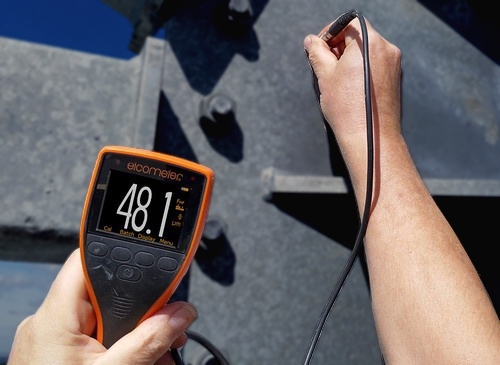
理想的な粉体塗装の厚みを得るには?
適切な厚みを得るには、単にパウダーを吹き付けるだけでは不十分だ。適切な下準備、適切な道具、そしてすべての工程における注意が必要なのだ。
表面処理
下地処理はコーティングを成功させるための基本です。きれいに下処理された表面は、密着性と膜厚の均一性を高めます。
- クリーニング:油、ほこり、さびを脱脂またはアルカリ洗浄で除去する。
- 前処理:リン酸塩系またはジルコニウム系のコーティングを使用し、接着を強化する。
- ブラストプロフィール:サンドブラスト加工された部品には、1.5~2.5ミル(38~63ミクロン)のアンカープロファイルがパウダー付着に理想的です。
アプリケーション設定の制御
スプレーパラメーターの制御は非常に重要です。静電スプレーガンを使用し、部品の形状に基づいて設定をダイヤルします。
- 電圧標準的な部品では60~90kVが一般的である。より高い電圧はラップを増加させるが、使い過ぎると逆電離を引き起こす可能性がある。
- 銃の距離:部品から8~12インチ離してください。より近い距離でスプレーをすると、付着物が多くなります。
- 粉体出力:安定した膜を作るには、毎分150~200グラム程度に保つこと。
ほとんどの用途では、乾燥膜厚2.0~3.0ミル(50~75ミクロン)を目指しています。5.0milを超えるコーティングは、ひび割れや未硬化のパウダーを内部に閉じ込める可能性があります。
監視と測定
コーティング中とコーティング後の測定は、エラーを防止します。
- キュア前の見積もり:櫛形ゲージは、ポストキュアの厚さ2.5ミル±10%を目標にするのに役立ちます。
- ポストキュアツール:校正済みのデジタル磁気ゲージまたは渦電流ゲージを使用する。精度は ±1% 実際の厚さの
- テストポイント:平坦部、エッジ部、カーブ部、リセス部の少なくとも5箇所をチェックする。これにより、コーティングの均一性が確保される。
機器のメンテナンス
一貫性のない機材は、相反する結果をもたらす。
- 火薬の詰まりを防ぐため、ガンとホッパーは毎日清掃する。
- 試験治具を使用して、毎週電圧出力をチェックする。
- オーブンの均一性は重要であり、温度プローブで庫内全体の熱が±10°F以内であることを確認する。
結論
パウダーコーティングの厚みは、パーツの寿命、外観、性能に大きく影響します。薄すぎると、早期に欠けたり錆びたりします。厚すぎると、ひび割れや剥離が生じたり、フィット感に問題が生じたりします。理想的な範囲は、通常2.0~5.0ミル(50~125ミクロン)で、部品の使用場所や使用方法によって異なります。
お客様の部品に適した粉体塗装の膜厚を得るためにお困りですか? チームへのお問い合わせ 専門家によるサポートと迅速で信頼性の高いサービスのために。

ケビン・リー
レーザー切断、曲げ加工、溶接、表面処理技術を専門とし、板金加工において10年以上の実務経験があります。シェンゲンのテクニカルディレクターとして、複雑な製造上の課題を解決し、各プロジェクトにおける革新と品質の向上に尽力しています。

